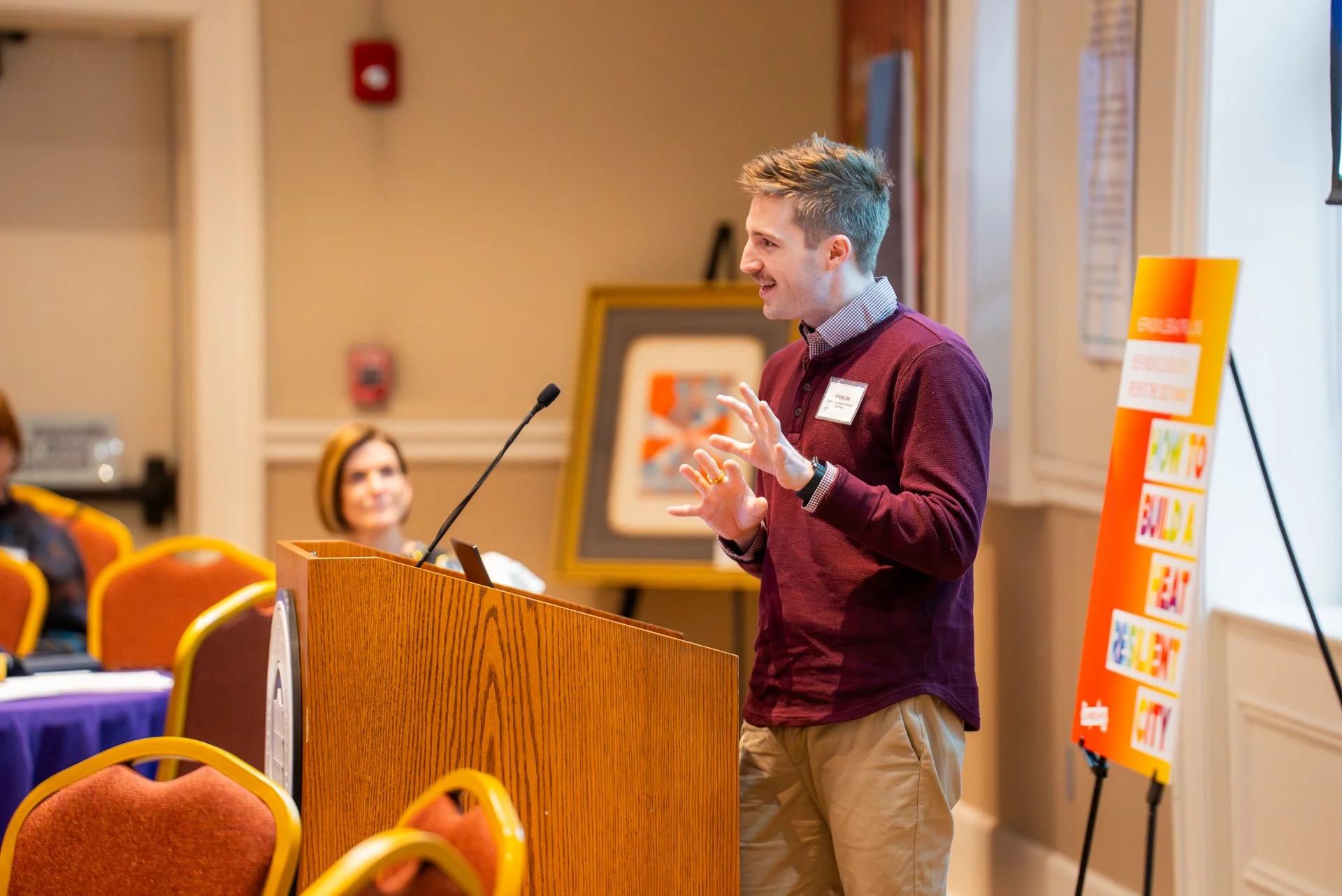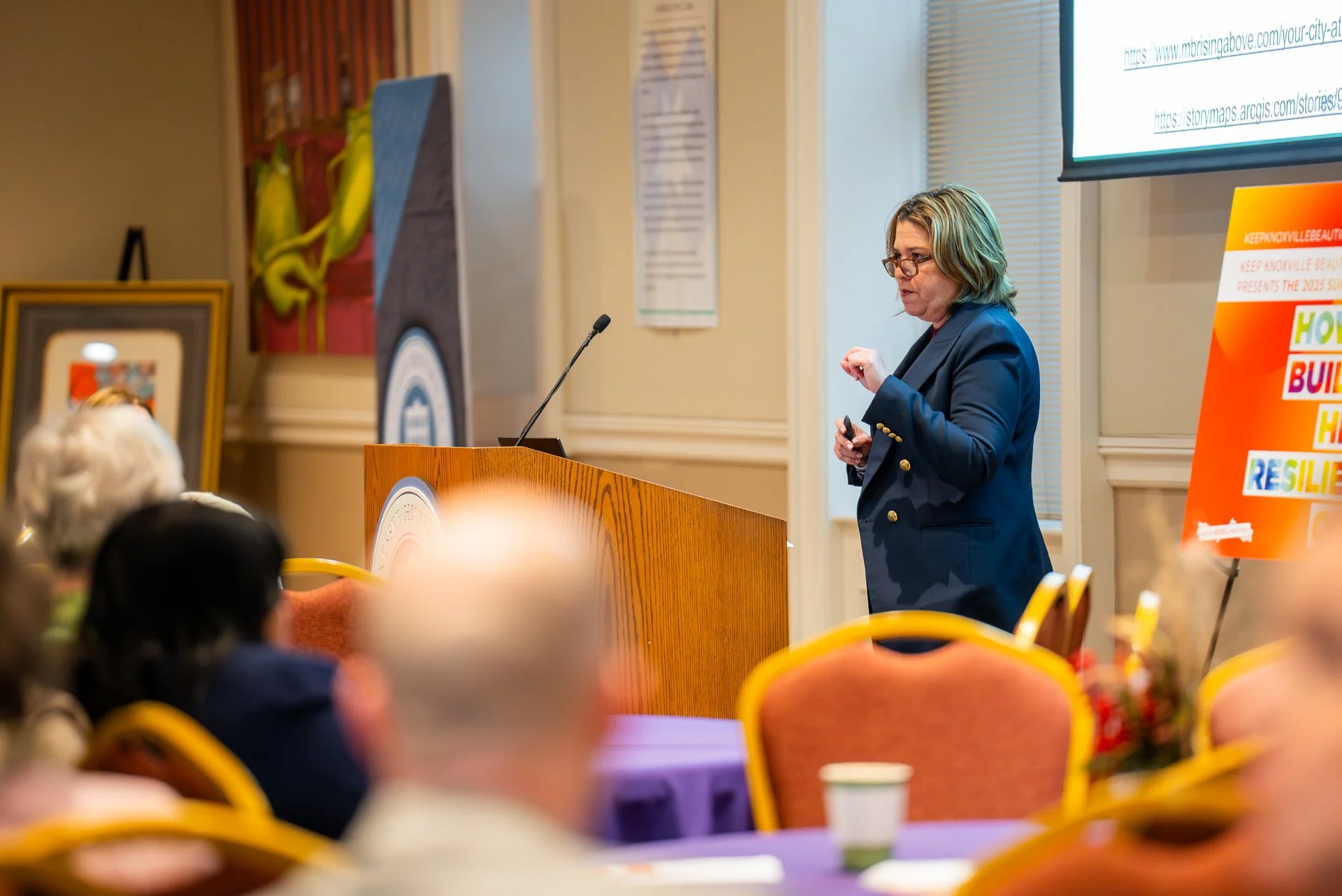KKB 6th Annual Summit Recap: Building a Heat-Resilient City
On February 7th, Keep Knoxville Beautiful hosted our sixth annual Summit at the East Tennessee History Center. With 2024 being the hottest year on record, this year’s theme was How to Build a Heat-Resilient City, showcasing three notably warm cities (Tempe, AZ; Pacoima, CA; and Miami, FL) that are setting the example on how to succeed in this age of climate warming. We heard from three innovative experts on combatting such heat extremes through climate action plans, mitigating urban heat with cool surfaces, and developing resilience hubs. Here’s our recap of this year’s insightful and inspiring discussion topics!
Kendon Jung, Arizona State University, Tempe, AZ
Kendon Jung speaking at the 6th annual KKB Summit. Photo by: ZC Productions
Moving at the Speed of Trust
Representation | With a charge “To research, advise, and recommend to the city council policies and programs that advance sustainability in Tempe”, Kendon was able to round up key stakeholders that represented important areas of Tempe needed to push forward a climate action plan in 2019: youth, businesses, climate justice, and neighborhoods.
Imagination | By following the examples of successful green construction advancements in Scottsdale, AZ (beginner), San Jose, CA (intermediate), and Israel (advanced), AIA (American Institute of Architects) Metro Phoenix held a design competition to imagine Tempe with green construction building coding that would advance the city from a novice to an expert place of sustainability and urban cooling. This in turn led the city to adopt the International Green Construction Code.
Collaboration | With the year 2020 having more than 20 days of observed temperatures over 110°F in Tempe, collaboration was needed to formulate emergency game plans that would brace for such extreme weather instances, and decrease the impact of such occurrences through everyday action. This in turn led Tempe to follow in the footsteps of such places as Orlando, FL, Austin, TX, and even Puerto Rico for their establishment of resilience hubs to deliver emergency management and community resilience.
Patience | Such sustainable relief doesn’t pop up overnight. The City of Tempe's Sustainability and Resilience Commission helped the city of 160,000 to become a leader in sustainability in under 7 years with the adoption of a Climate Action Plan which started with the establishment of the commission in 2015, to the passing of the Climate Action Plan’s updates in 2022. Along the way $2.5M was awarded in external grants (2020), as well as $525k being lobbied to secure funding. Determination, trust, imagination, collaboration, and patience helped Tempe to gain centralized support for the Sustainability and Resilience Office, and the future of Tempe.
“Climate work is culture work”
Drew Ramsey, GAF / Streetbond, Parsippany, NJ
Drew Ramsey speaking at the 6th annual KKB Summit. Photo by: ZC Productions
Neighborhood Approaches to Mitigating Urban Heat
What is the Urban Heat Island | Compared to outlying green spaces, urban environments are increasing in temperature due to the absorption and trapping of heat from concrete and asphalt used in urban building materials. This in turn leads to increased health risks for vulnerable communities like the elderly and those with chronic illnesses, as well as increased prevalence of heat strokes, and cardiovascular disease.
How Communities are Impacted & Engaged | Impoverished communities and communities of color are experiencing the worst end of the urban heat island effect as they’ve been historically displaced in areas susceptible to environmental injustices. This in turn exposes them to higher levels of air pollution, flooding, extreme heat, and heat-related deaths – the leading weather-related cause of death in the U.S.
How Cool Surfaces Can Help | Surfaces (above or below you) play a major role in the heat you feel on any given day. As previously mentioned, ground surfaces like asphalt and concrete absorb and trap heat from the sun, but roofing also plays a part in similar circumstances. Both ground and roofing surfaces reflect or absorb heat depending on the color of the surface (albedo). The lighter the color, the more solar radiation and heat are reflected toward the sun and atmosphere, cooling the Earth’s surface. Such cooling solutions like vegetated roofing, solar panels, and coating bases like StreetBond® for roofing and pavement are proving to aid in the heating crisis that our urban environments are experiencing.
“We’ve got to cool these surfaces off before people get more hurt”
Susy Torriente, Jacobs, Miami, FL
Susy Torriente speaking at the 6th annual KKB Summit. Photo by: ZC Productions
How to Build a Heat-Resistant City? Projects, Products & People
Understand Data & Impacts | To create a heat-resistant city and resilient community, Susy emphasized the necessity of collecting data, so that we can understand the impact such heat extremes are having on the community and people.
Create Plans & Find Leadership Champions | Once such impacts are realized, a strategy to combat such climate problems should follow. These heat strategies should be led by champions in the sector. These leaders are more notably known and established as Chief Heat Officers.
Modernize Projects & Procure New Products | One-off projects to mitigate climate warming such as solar panels, electric vehicles, or implementing more green infrastructure aren’t one-and-done solutions. Susy highlighted the need to institutionalize projects and train staff to make such efforts long-lasting and effective.
Institutionalize with Policies | A heat-resilient city needs to create policies and standards i.e. standardizing design guidelines for playgrounds, green building ordinances, personnel guidelines, union contracts, and institutionalized roles so that such projects can become the norm throughout the community. Having experts in water, landscape, engineering, building coding, air quality, etc. are excellent additions to discuss at the policy level for institutionalization.
Culture of Resilience | Greater Miami & The Beaches Coalition of Miami, Miami Dade, and Miami Beach became the first trio organization to join 100 resilient cities, which led to the creation of a resilient strategy for the county - Resilient305 : Miami-Dade Countywide Resilience Hub Network Strategy. Such a strategy and guidebook helps communities to assess, evaluate, and implement their own resilience hubs. Such steps and tools for this establishment follow:
Resilience Hub - physical places that can be altered to service community daily needs, hazard mitigation, and serve in an emergency mode for preparedness and recovery. Hubs serve the hyper-local purpose but serve as the front line of defense in emergencies.
Vulnerability Assessment - assess climate, social, and infrastructure vulnerabilities to identify the least vulnerable sites (safest) that are distinct, geographically dispersed, and unique that can used for your hub. Such as a church, social services community center, or neighborhood park.
Site evaluation - is it safe, connected to the community, has utilities, trustworthy (already being used regularly)?
Communication protocol - an emergency and standard operating plan needs to be created with roles identified.
Implementation Task Force - be sure to have an implementation plan, funding plan, building infrastructure, build and strengthen relationships, and a plan for community integration into hubs = Successful Hub Management
“To make lasting change, it has to operate through policy”



